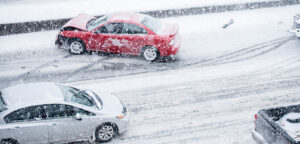Menu

One of the most important things you can do when driving in winter weather is to reduce your speed. Even if the roads are merely wet, it’s essential to adjust your driving to account for possible ice patches, especially on bridges, overpasses, and shaded areas. Driving too fast for the conditions can lead to loss of traction and difficulty stopping.
Always drive at a speed that allows you to react safely to road conditions. Give yourself extra time to stop, and leave plenty of space between your vehicle and others.
In winter conditions, stopping distances are longer due to slippery roads. Increase your following distance to at least 6-8 seconds behind the car in front of you. This extra space gives you more time to react if the vehicle ahead of you suddenly slows down or stops.
Avoid tailgating, as it can lead to rear-end collisions in slippery conditions. Always be aware of your surroundings and adjust your driving distance accordingly.
Before heading out, take the time to clear all snow and ice from your car, including the roof, windows, headlights, and taillights. Snow or ice on the roof can slide down onto your windshield or the vehicle behind you, obstructing your vision and creating a dangerous situation for others on the road.
Ensure that your windshield wipers and defroster are working properly to keep your visibility clear. Clear all windows, mirrors, and lights to improve your ability to see and be seen by other drivers.
Driving in winter conditions often means dealing with low visibility due to snow, fog, or dark days. Always turn on your headlights, even during the day, to ensure other drivers can see you. In foggy conditions, use your low-beam headlights, as high beams can reflect off the fog and reduce visibility.
In heavy snow or rain, be sure to keep your headlights on to make yourself more visible to other vehicles, particularly those traveling in the opposite direction.
In icy conditions, sudden movements such as sharp turns, rapid acceleration, or hard braking can cause your vehicle to skid or lose control. Avoid jerky steering or braking, and instead, make gradual and smooth adjustments.
When turning, slow down before you reach the turn and avoid braking while turning. If you must brake, do so gently to avoid skidding. If your vehicle does start to skid, remember to steer in the direction you want to go and avoid slamming on the brakes.
To avoid breakdowns and accidents, it’s essential to prepare your car for winter conditions. Make sure your vehicle’s battery, brakes, tires, lights, and windshield wipers are in good condition. Check your antifreeze levels, oil, and fuel system to ensure they are ready for cold temperatures. If you live in an area with heavy snow and/or ice, consider changing your tires to winter tires.
Additionally, consider carrying an emergency kit that includes a blanket, gloves, extra warm clothing, a flashlight, first aid supplies, and non-perishable food and water. This can be invaluable in case you get stranded or experience an emergency.
Before hitting the road, always check the weather forecast and road conditions. Knowing what to expect can help you plan your trip and avoid dangerous driving conditions. If snowstorms, ice, or freezing rain are expected, it’s better to delay your trip or take alternative routes.
If you do need to drive during bad weather, listen to local radio or check weather apps for real-time updates on road conditions and accidents.
Using cruise control in winter weather can be dangerous, especially when roads are slick. Cruise control can cause your vehicle to maintain speed regardless of changing conditions, which might cause you to lose control if you hit a patch of ice or snow. Always stay in full control of your vehicle by manually adjusting your speed and braking as needed.
Despite all precautions, you may still encounter a situation where your car starts to skid. Knowing how to react can make a difference. If you begin to skid on ice or snow:
Driving in winter conditions requires extra care, patience, and attention to detail. By slowing down, increasing your following distance, preparing your vehicle, and making adjustments based on weather conditions, you can reduce your risk of accidents during the colder months. Always stay alert, drive cautiously, and be proactive in ensuring your vehicle is equipped to handle the challenges of winter roads. By following these safety tips, you’ll be much better prepared to navigate through winter driving conditions and keep yourself and others safe on the road.
If you were hit by someone who was not driving safe in winter weather, give Titans Legal a call today and we can help. 214-488.8888